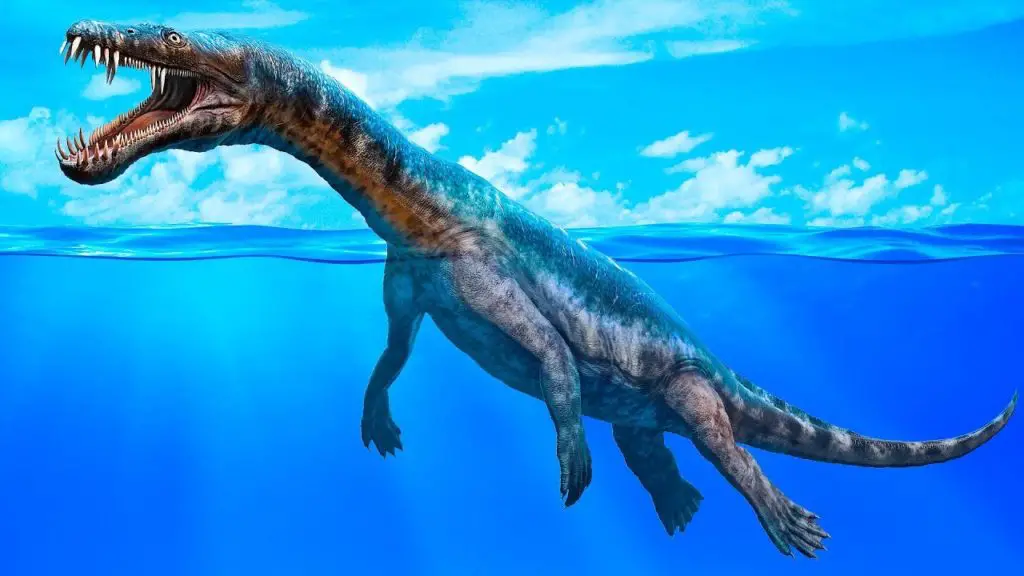Archelon
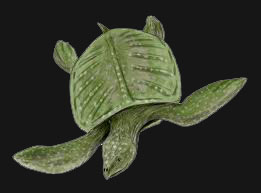 Archelon is the largest extinct species of turtle that was ever discovered.
Archelon is the largest extinct species of turtle that was ever discovered.
Cryptoclidus
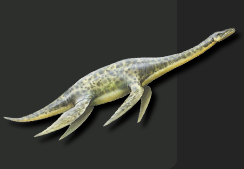 Cryptoclidus were not dinosaurs. They were from the plesiosauria group which consisted of many marine reptiles.
Cryptoclidus were not dinosaurs. They were from the plesiosauria group which consisted of many marine reptiles.
Dactylosaurus
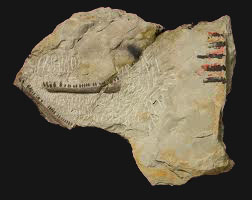 Dactylosaurus was one of the earliest known pachypleurosaurs to be discovered from Europe.
Dactylosaurus was one of the earliest known pachypleurosaurs to be discovered from Europe.
Dallasaurus
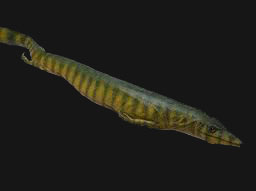 Dallasaurus was a land-dwelling species that had become fully aquatic.
Dallasaurus was a land-dwelling species that had become fully aquatic.
Dinocephalosaurus
 This marine reptile was originally described as capable of sucking in fish by expanding its neck cervicals to create an inrush of water. Dinocephalosaurus would have been a stealthy bottom-dweller with eyes able to look dorsally. When fish came within its strike-zone, the long neck could raise the toothy skull to snare one.
This marine reptile was originally described as capable of sucking in fish by expanding its neck cervicals to create an inrush of water. Dinocephalosaurus would have been a stealthy bottom-dweller with eyes able to look dorsally. When fish came within its strike-zone, the long neck could raise the toothy skull to snare one.
Dolichorhynchops
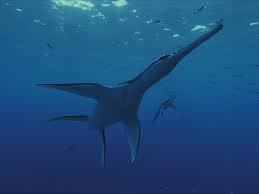 Dolichorhynchops (Greek for “long-snouted face”) is pronounced DOE-lih-co-RIN-cops.
Dolichorhynchops (Greek for “long-snouted face”) is pronounced DOE-lih-co-RIN-cops.
Elasmosaurus
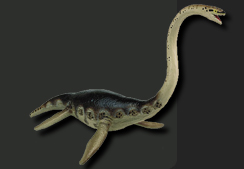 Elasmosaurus are of the plesiosauria group. They are not dinosaurs, but marine reptiles that were in the waters during the three dinosaur periods.
Elasmosaurus are of the plesiosauria group. They are not dinosaurs, but marine reptiles that were in the waters during the three dinosaur periods.
Eonatator
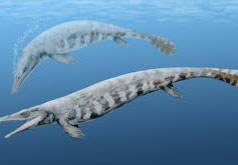 Eonatator is a genus of halisaurine mosasaur from the Upper Cretaceous of North America and Europe.
Eonatator is a genus of halisaurine mosasaur from the Upper Cretaceous of North America and Europe.
Futabasaurus
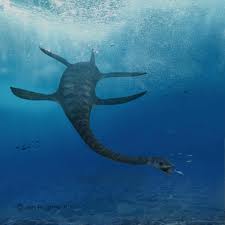 Futabasaurus was Described and named in 2006.
Futabasaurus was Described and named in 2006.
Globidens
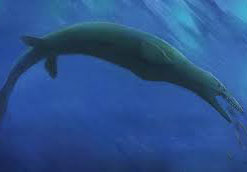 Globidens was about 20 feet long and 1,000 pounds.
Globidens was about 20 feet long and 1,000 pounds.
Hainosaurus
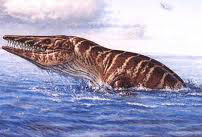 Hainosaurus was on the giant end of the evolutionary spectrum, measuring almost 50 feet from snout to tail and weighing as much as 15 tons. This marine reptile, fossils of which have been found in Asia.
Hainosaurus was on the giant end of the evolutionary spectrum, measuring almost 50 feet from snout to tail and weighing as much as 15 tons. This marine reptile, fossils of which have been found in Asia.
Henoduschelyops
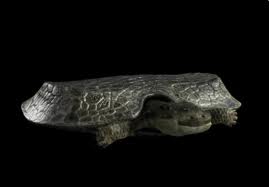 Henoduschelyops was from the Triassic period, about 228 million to 200 million years ago.
Henoduschelyops was from the Triassic period, about 228 million to 200 million years ago.
ichthyosaurus
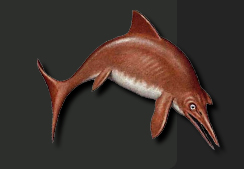 Ichthyosaurus was of the Plesiosauria group. They are not considered dinosaurs.
Ichthyosaurus was of the Plesiosauria group. They are not considered dinosaurs.
Keichousaurus
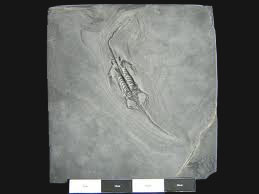 China was where the first fossil specimen of this marine reptile was discovered back in 1957.
China was where the first fossil specimen of this marine reptile was discovered back in 1957.
Kronosaurus
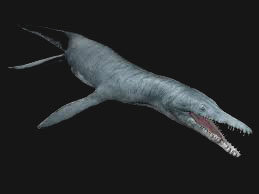 the Kronosaurus length probably being about 9–10 meters.
the Kronosaurus length probably being about 9–10 meters.
Lariosaurus
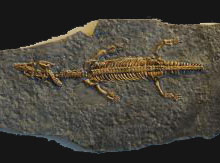 Lariosaurus was discovered from the coastal areas of Western Europe.
Lariosaurus was discovered from the coastal areas of Western Europe.
Libonectes
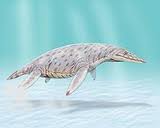 Libonectes had four strong, muscular flippers for swimming quickly through water as it kept its body stable by swallowing rocks. Plesiosaurs were once believed to have been able to raise their neck and head high above the surface of the water.
Libonectes had four strong, muscular flippers for swimming quickly through water as it kept its body stable by swallowing rocks. Plesiosaurs were once believed to have been able to raise their neck and head high above the surface of the water.
Liopleurodon
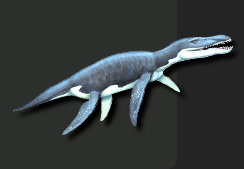 Liopleurodon are considered to be absolutely massive. They are of the Plesiosauria group and are not Dinosaurs.
Liopleurodon are considered to be absolutely massive. They are of the Plesiosauria group and are not Dinosaurs.
Nothosaurus
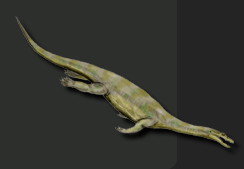 Nothosaurus was from the Plesiosauria group and was not a dinosaur. This group consisted of marine reptiles.
Nothosaurus was from the Plesiosauria group and was not a dinosaur. This group consisted of marine reptiles.
Plesiosaurus
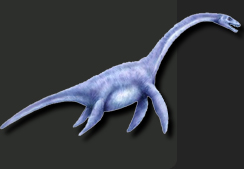 Plesiosaurus was not a dinosaur. It was part of the Plesiosauria group.
Plesiosaurus was not a dinosaur. It was part of the Plesiosauria group.
Psephoderma
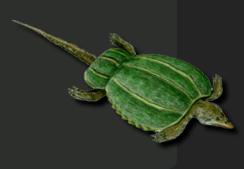 The Psephoderma was not a dinosaur. It was actually from a group of swimming reptiles called Placodonts. This speces had a lot in common with today’s turtles.
The Psephoderma was not a dinosaur. It was actually from a group of swimming reptiles called Placodonts. This speces had a lot in common with today’s turtles.
Shonisaurus
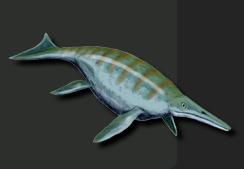 Shonisaurus was first discovered in 1920. The name actually means “Lizard from the Shoshone Mountains” in Greek.
Shonisaurus was first discovered in 1920. The name actually means “Lizard from the Shoshone Mountains” in Greek.
Stenopterygius
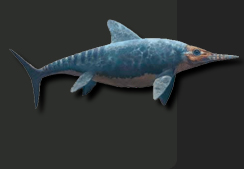 Unborn infants of some of the Stenopterygius fossils were found inside what would be the belly of a full grown Stenopterygius. It was concluded that they gave birth to live babies, not eggs.
Unborn infants of some of the Stenopterygius fossils were found inside what would be the belly of a full grown Stenopterygius. It was concluded that they gave birth to live babies, not eggs.
Tylosaurus
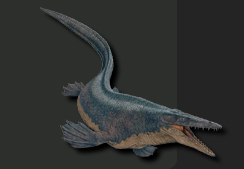 Tylosaurus was not a dinosaur it was part of a different group of species. The group consisted of Marine mammals and reptile. This group was called Plesiosaurs.
Tylosaurus was not a dinosaur it was part of a different group of species. The group consisted of Marine mammals and reptile. This group was called Plesiosaurs.
Extinct Marine Reptiles
From a very old era to the present day different marine reptiles were known to have been disappeared. A lot of animals and plants were known to have lived during the Mesozoic era along with dinosaurs. Some of these reptiles were intimately related to dinosaurs like pterosaurs, but these were not dinosaurs.
During the late Cambrian period, an animal called trilobites, which is arthropods like insects, is known to have lived in the sea. This animal is known to have lived around 500 million years ago, even before the period of dinosaurs. Some million years later, during the Paleozoic era, an animal called dimetrodons were known to have lived. Let us see some of the marine reptiles that lived during the pre-historic period.
Ammonite
The term ammonite is pronounced as Am-uh-nites and these were early mollusks. These animals had no spinal column and they were protected by a shell made out of calcium. These animals were known to have eaten other animals in the sea and they were fast-moving as well. Ammonites were known to have been in different sizes ranging from one inch to about 3m in diameter. These were known to have lived in Mesozoic era, but were not found in the cretaceous period.
Cryptoclidus
This was a marine reptile that was around 4m long. Cryptoclidus were known to have lived during the Jurassic period around 150 million years ago. It had large paddle like flippers, a wide skull and interlocking and curved teeth. The prey of these animals was squid and fish and it also ate crustaceans. The fossils of this animal were found in France , England and South America .
Gerrothorax
Gerrothorax was a marine animal that was about one meter long. It had a flattened body and so it looked it a large tadpole. The specialty of this animal is that it had three pairs of gills and these gills would have presented in this animal right from its birth to death, so it could have lived in water even after growing. It had a wide and short head, two close-set eyes and the eyes were very small and a small tail. It was known to have lived about 200 million years ago during the Triassic period. It was known to have been a meat eater.
Ichthyosaurs
These were strong swimming marine reptiles fully adapted to live in the sea. Even though, these reptiles were known to have lived in sea, they might have reached the surface periodically for the purpose of breathing air. They were of different sizes up to a maximum of 9m long. They had big eyes and sharp teeth and fish like tail with two lobes. They had a stabilizing dorsal fin and four crescent-shaped fins. Fossils of this animal were found with baby ichthyosaurs in the abdomen. So, they would have been viviparous giving birth to young ones and not laying eggs. They were known to have lived during the Mesozoic Era about 95 million years ago. The diet of this animal was octopus, fish and other animals swimming in the water. Its sharp teeth and strong jaws would have helped for easy hunting.
Megalodon
Megalodon was an ancient shark, which was known to have lived 25 million years ago. It was known to have been around 12m long. But, researchers feel that it would have been even longer since this size of megalodon is not proved. From the fossils of this great shark it would have got giant teeth and the size of the teeth along would be nearly the size of a person’s hand. Apart from the teeth, no other part of the body of this animal was found. It would have eaten whales as its prey.
Mosasaurs
This was a snake-like water living reptile. These animals were closely related to monitor lizards and snakes. They might have lived in shallow seas. The term mosasurs is spelled as moes-ah-sawr. They were known to have lived around 65 million years ago. The first mosasurs was found in the year 1780 at the Netherlands . Some of these species were found in north Atlantic and some others were found in south Atlantic . They would have eaten turtles, fish and mollusks. They had strong teeth, which was used by the animal for crushing shelled animals for consuming them. They would have spent most of their time in water and they would have swum like a snake with the help of their finned tail.
Trilobite
These were marine animals with hard-shell and they would have lived around 500 million years ago. Researchers suggest that Trilobite would have got over 15000 species some of these species were known to have swum, some drifted with ocean currents and some other crawled along the sea floor. Each Trilobite would have followed its own diet, some were plant-eaters, some were scavengers and some other ate decayed materials. It had got this name because it had three-lobed shells. The body of these animals is divided into three parts, namely head, thorax and the tail. They had antennae, compound eyes and jointed legs. They were in different sizes ranging from ¼ inch to 2 feet long.
Nothosaurs
Nothosaurs were marine reptiles, which had long tail, long neck and which was around 6m long. They were fish eaters and they had paddle like limbs with toes and webbed fingers. These reptiles had long teeth and the back teeth were shorter than the front teeth. These had nostrils on the top end of the nose. They were known to have been lived during the Triassic period. They might have used their paddle limbs for swimming. The fossils of this animal were found in Netherlands , Germany , Switzerland and Italy . They were found in Asia and North Africa as well. Even though, they have spent most of the time in water, they were known to have spent time in land as well.
Apart from the above-mentioned marine reptiles, there were hundreds of other extinct marine reptiles that had existed as well.


